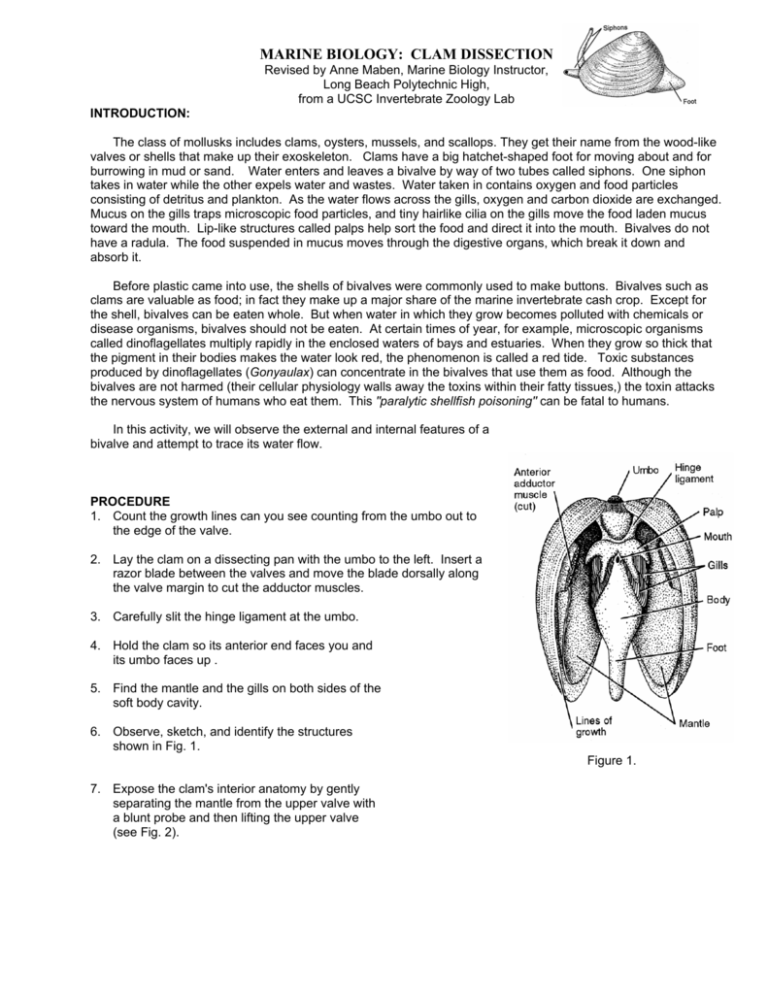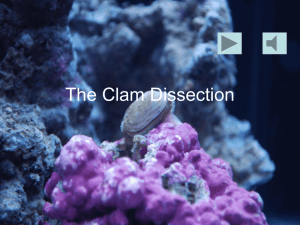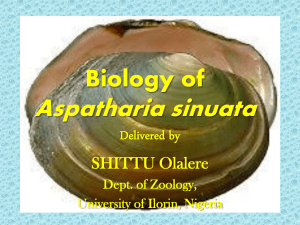marine biology: clam dissection
advertisement

MARINE BIOLOGY: CLAM DISSECTION Revised by Anne Maben, Marine Biology Instructor, Long Beach Polytechnic High, from a UCSC Invertebrate Zoology Lab INTRODUCTION: The class of mollusks includes clams, oysters, mussels, and scallops. They get their name from the wood-like valves or shells that make up their exoskeleton. Clams have a big hatchet-shaped foot for moving about and for burrowing in mud or sand. Water enters and leaves a bivalve by way of two tubes called siphons. One siphon takes in water while the other expels water and wastes. Water taken in contains oxygen and food particles consisting of detritus and plankton. As the water flows across the gills, oxygen and carbon dioxide are exchanged. Mucus on the gills traps microscopic food particles, and tiny hairlike cilia on the gills move the food laden mucus toward the mouth. Lip-like structures called palps help sort the food and direct it into the mouth. Bivalves do not have a radula. The food suspended in mucus moves through the digestive organs, which break it down and absorb it. Before plastic came into use, the shells of bivalves were commonly used to make buttons. Bivalves such as clams are valuable as food; in fact they make up a major share of the marine invertebrate cash crop. Except for the shell, bivalves can be eaten whole. But when water in which they grow becomes polluted with chemicals or disease organisms, bivalves should not be eaten. At certain times of year, for example, microscopic organisms called dinoflagellates multiply rapidly in the enclosed waters of bays and estuaries. When they grow so thick that the pigment in their bodies makes the water look red, the phenomenon is called a red tide. Toxic substances produced by dinoflagellates (Gonyaulax) can concentrate in the bivalves that use them as food. Although the bivalves are not harmed (their cellular physiology walls away the toxins within their fatty tissues,) the toxin attacks the nervous system of humans who eat them. This "paralytic shellfish poisoning" can be fatal to humans. In this activity, we will observe the external and internal features of a bivalve and attempt to trace its water flow. PROCEDURE 1. Count the growth lines can you see counting from the umbo out to the edge of the valve. 2. Lay the clam on a dissecting pan with the umbo to the left. Insert a razor blade between the valves and move the blade dorsally along the valve margin to cut the adductor muscles. 3. Carefully slit the hinge ligament at the umbo. 4. Hold the clam so its anterior end faces you and its umbo faces up . 5. Find the mantle and the gills on both sides of the soft body cavity. 6. Observe, sketch, and identify the structures shown in Fig. 1. Figure 1. 7. Expose the clam's interior anatomy by gently separating the mantle from the upper valve with a blunt probe and then lifting the upper valve (see Fig. 2). 8. Draw and label the internal parts of your clam as seen from this view. 9. Reposition the clam with its umbo to the left as shown in Figure 3. Lift and fold the top mantle to expose the gills and body cavity below. Draw and label the internal parts of your clam with the structures found in Table 1 of the discussion. 10. Using different-colored pencils or crayons, sketch arrows on your drawing to show the pathway of food and water into and out of the clam's body. 11. Describe the functions of each major part in Table 1 of the Discussion. Figure 2. Figure 3. ANATOMICAL FEATURE adductor muscles digestive gland excurrent siphon foot gills hinge ligament hinge teeth incurrent siphon intestine lines of growth mantle muscle scars nacre pallial line palps stomach umbo FUNCTION QUESTIONS FOR DISCUSSION: 1. How many growth lines can you see counting from the umbo out to the edge of the valve? 2. What part of the clam secretes the shell? 3. What chemical does it secrete? 4. What effect does the cutting of the muscles have on the valves? 5. How many gills does the clam have? 6. How do the gills play a part in food gathering? 7. What is the specific function of the muscular foot in clams? 8. Why is a continuous circulation of water essential to the clam? 9. Why do you think the outlet of the digestive system is near the excurrent siphon?











